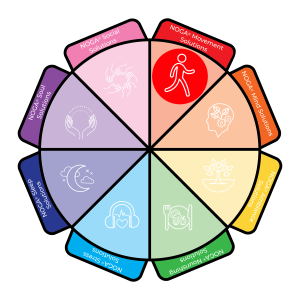WHAT’S THE BEST TYPE OF EXERCISE FOR ME TO DO? (Read more 🙂)
 In the previous article we discussed NOGA®’s “Wheel of Wellbeing™” (CLICK HERE to read it again) which gives us the ability to enhance our health and wellbeing incrementally. In this process, we are able to authentically assess our own Mission, Vision, and Purpose (MVP) vis a vis where we currently are. (I call this our MVP, which someday we will discuss, please G-d.)
In the previous article we discussed NOGA®’s “Wheel of Wellbeing™” (CLICK HERE to read it again) which gives us the ability to enhance our health and wellbeing incrementally. In this process, we are able to authentically assess our own Mission, Vision, and Purpose (MVP) vis a vis where we currently are. (I call this our MVP, which someday we will discuss, please G-d.)
In the upcoming installments, I hope to share basic ideas from each section of the “Wheel” for you to better understand and then enhance your own healthy practices. Going from right, clockwise, the first area, RED, is Movement. Many people who don’t have an exercise regimen are overwhelmed by even the mention of the word “exercise” (as well as the four-letter word, DIET – which we will discuss in an upcoming installment). For people intimidated by the word, the ideal “10” might be getting outside and walking somewhere for at least 10 minutes 3 days a week. For another person for whom it is easy to go to the gym every day, a “10” would be something more than what they’re used to. For instance, maybe in addition to their daily gym regimen, they use equipment at home for at least another ½ hour again daily. An important caveat is that everyone has a different threshold, a different need, and a different desired approach to introducing movement into their lifestyle.
Once a client asked me, “What’s the best type of exercise for me to do?” Do you know what I told her? “The one you’re going to do.” I cannot prescribe something that a person will resist, refuse, or resent! Each person needs to think of his or her own individual ideal image in the movement category, be realistic about where s/he is today, and then grow incrementally, little by little toward his/her own “10.”
Don’t forget that movement is movement. Your body is not prejudiced to walking or swimming over biking or tennis, or even over gardening and housekeeping!!!! Those are all forms of movement. Consider the neat acronym, “N E A T.” It stands for “Non-Exercise Activity Thermogenesis.” That means, things that aren’t called exercise can and do burn calories (i.e., causing thermogenesis). Consider housekeeping, working on a car, or another project.
Imagine a person who is gardening. When she “does it right,” there’s shlepping and walking, and bending, and lifting, and pushing, and pulling, and more!!! Even parking a car a block or two away from where you’re headed means you get in extra walking steps. I use a Fitbit, others might use an Apple Phone, Apple Watch, a Garmin, etc. for tracking steps and other movements. You start where you are able to start (and measuring yourself helps)! Can you begin with 1000 steps a day? Can you move a little bit more daily? Some people aspire to take 10,000 steps a day. That may be way out of your league (today 😉 and may not be your goal. Just see how many steps come in your natural, day-to-day activities, then try to improve little by little.
Check this out! There was a famous study in 2007, colloquially called the “Hotel Maids Study” by Ellen Langer, et. al.* Here is the abstract:
In a study testing whether the relationship between exercise and health is moderated by one’s mind-set, 84 female room attendants working in seven different hotels were measured on physiological health variables affected by exercise. Those in the informed condition were told that the work they do (cleaning hotel rooms) is good exercise and satisfies the Surgeon General’s recommendations for an active lifestyle. Examples of how their work was exercise were provided. Subjects in the control group were not given this information. Although actual behavior did not change, 4 weeks after the intervention, the informed group perceived themselves to be getting significantly more exercise than before. As a result, compared with the control group, they showed a decrease in weight, blood pressure, body fat, waist-to-hip ratio, and body mass index. These results support the hypothesis that exercise affects health in part or in whole via the placebo effect.
So, back to NOGA®’s “Wheel of Wellbeing™” (CLICK HERE to download) in the area called ‘Movement Solutions’ consider the optimal or ideal image of where your movement practice would look like (10) and find where you are on the segment on the “Wheel” currently. If you’re very dissatisfied with where you are, it may be a 1 or a 2. If you’re doing something good, but you know you could be doing more, maybe you would “score” yourself at a 5 or 6 out of 10. Once you’ve found your current level, annotate what activity or activities you are doing near the line. Then, when you step up your own ladder and get to the next rung in your movement practice, be proud and savor your accomplishment. Share it with others to have it sink in. Stay accountable with friends or family who are supportive of your goals and values if you are able. Maybe they want to do this along with you. I give full permission for you to share this with a partner or friend to work on the “Wheel.” Accountability with those who share our values really keeps us in line with our own. More awareness and involvement in it will ultimately enhance your well-being.Enjoy the “Wheel,” and let me know what you think. Please share your hacks and successes with me too!
Other free downloadable resources can be found HERE.
We love hearing from you, please feel free to leave your comments below.
With Gratitude,
Rus Devorah


